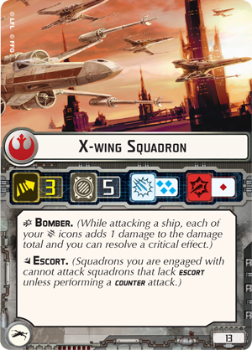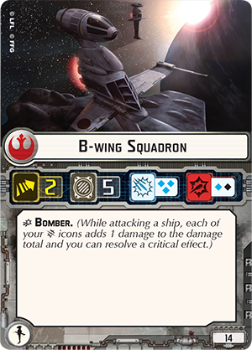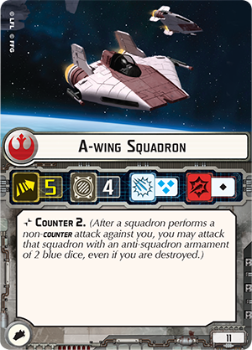Welcome back to Special Modifications!
Han Solo once said he’d made a few “special modifications” to the Falcon. Some good, some bad, all of them interesting. That’s the spirit behind this new series: exploring nonstandard Armada. Not just fleet lists or tournament meta, but the underlying strings that hold the game together. What if the designers had pulled them differently? What might have worked better? What happens when you tinker with the system in ways it was never quite built for?
Lock S-Foils in Attack Position
Let’s start with the Rebels — not just because they’re the OG squadron faction, but also because they received more boosts, patches, and fixes than anyone else to get their core squadrons into a good place. And yet… how often do you really see X-wings take center stage in anything but an obnoxious Biggs Ball? How often do you see B-wings in an alphabet soup? Generic A-wings in any number? Don’t you cry a little bit when you see GAR Y-wings with their blue-black anti-squad combo and realize what the Rebel version could have been? And then you just shrug and take Rogues instead? Yeah, me too.
That said, I don’t think Rebel generics are beyond saving. Far from it. We don’t need to redesign the whole system — just a few core tweaks to make them worth taking without leaning on a tower of support pieces.
And once we’ve looked at Rebels, we can assess the Empire in contrast — always keeping GAR and CIS in mind as the better-balanced baselines. Regarding costing, we're going to push the cost of generics down by a point or so, unless we give them a significant boost, in which case we'll do a more thorough reevaluation.
X-wing
The most iconic starfighter in Star Wars. And in Armada? Not bad, but lackluster — and overpriced to boot. You never just throw a couple of X-wings into a Rebel fleet. Never.
The biggest issue is speed. Armada’s X-wing is sluggish. It doesn’t stand out from other mid-speed squadrons, which means you can’t build a dynamic squadron game — you’re always reactive. A slow escort doesn’t even make much sense thematically.
If you're also an X-wing player, the X-wing's slow speed feels even weirder. In fact, using the closed S-foil Boost, it is FASTER than a TIE Fighter! Not A-wing or TIE Interceptor, but the X-wing can MOVE!
Back in the 2022 VASSAL Fantasy League, we tried giving the X-wing (and B-wing) a new keyword: S-foil, basically choose +1 speed on activation, but remove 1 attack die. It worked pretty well, but at Armada’s scale, it felt fiddly.
A simpler fix: just make the X-wing Speed 4. Now it feels like an escort and space superiority fighter at the same time.
Next, its armament. Swap one blue for a black in the anti-squadron dice. This gives consistency and punch, and mixes up the pool — everything was “just blue” back in 2015, but Armada has moved toward more varied dice pools. (Also: Rebels don’t have much Swarm synergy, so a black die here helps.)
What about its anti-ship battery? Leave it as a single red. Yes, we could make it a black for more reliability, but that would crowd out the Y-wing’s role. And if we did that, then the Y-wing would need to become a two-die bomber, which would push its cost up and infringe on the B-wing’s niche. Slippery slope. Better to keep the X-wing as a secondary bomber at best.
Cost: 11 points.
More speed AND a 2-point drop? Have you gone mad, I hear you say. Bear with me, not only because my given name literally means "Bear," but because it's an interesting line of reasoning:
- 11 is the same as an FFG-priced Hyena, but that one is effectively a 2-die bomber, so a direct comparison is hard to make.
- In the space superiority role, the X-wing has to contend with TIE Ints and Tri-Fighters, both squadrons that hit as hard or harder, have more speed, and counter. But they are flimsy. So again, not easy to do a direct comparison.
- The YT-2400 has more hull, Rogue, and essentially the same offensive profile. We know YTs are super competitive at 16. Is the extra hull and Rogue worth +5 points (Escort is relevant for the YT-2400, so no real loss there)? Or maybe the YT-2400 should be 15? Or what about the proposed tweak to Rogue? How does that impact the equation?
All valid points, but let's take a step back and focus: the X-wing is one of THE core squadrons of the game, doesn't get much more iconic than this. So instead of looking around at what other squadrons (currently) cost, let's shift focus. Let's use 10 points as the baseline for a "good generic squadron" and compare the X-wing to that:
The X-wing has good(ish) speed, good(ish) hull (but not exceptional), goodish AS, mid battery with Bomber, and the Escort keyword (that is usually good, but means you'll die first too). IMO this sounds like the very definition of a slightly above average space superiority fighter.
I'd say my gut instinct is to put it at 12 points within the current costing paradigm. It came down in cost and gained speed, so now it offers good value for points, right? It does. But we wanted an overall reduction of generic squadron cost, didn't we? Thus, we push the X-wing down to 11. At least for now. If we later see that 11 is too low, we can shift back to 12, no problem.
So, not only is 11 the cost of our Xw-ing, it'll serve as our baseline going forward. We'll have to establish more baselines; one isn't going to cut it in the long run, but it's a solid foundation: build around the iconic X-wing.
Y-wing
This old workhorse has the same problem as the X-wing: not bad, but lackluster. Slow, Heavy, a single-die bomber that’s tankier than an X-wing but worse at dogfighting. Outside of high hull, which admittedly is quite important in a game with a fixed number of rounds, it doesn’t bring much. No, that's too harsh. It brings something, but it has no exceptional characteristics.
Making every Y-wing into Gold Squadron (double-die bomber) would be too much. It would drive the price up quite a bit and crowd out the B-wing’s role. So let’s keep it as a cheap, single-die bomber. I think that fits quite well thematically as well. These are old ships, relics of a more civilized era, so to speak.
As for changes, let's adjust its anti-squadron armament to blue + black, just like the GAR version. We know this combo is a lot more useful than 2 blue. Sure, it'll give fewer ACCs (but so will the X-wing), but with such small dice pools, getting at least 1 damage on the target is more important. Suddenly, the Y-wing isn't a total dead weight in squadron fights.
Cost: 9 points.
If we do a comparison with the only squadron thus far detailed, we see they are 2 cheaper than X-wings, which doesn't seem like a lot, but in percentage terms, about 20%, it's rather significant. You can have 4 Y-wings for 36 points (24 hull) or 3 X-wings for 33 points (15 hull), and you toss 4 black Bomber dice instead of 3 red. The X-wings hit harder in AS mode (12 vs 8 die across 3 vs 4 attacks), have Escort, and are faster. That sounds like the right tradeoff.
Let's do an isolated study to see if the cost makes sense. 9 sounds like a mid squadron. Is the Y-wing mid? I would say yes. Black bomber dice (forget about PDIC, it's not part of the equation) are solid, so the battery part is above average (but not exceptional). AS is decidedly mid — but not horrible, we know that from GAR. Speed 3 is the definition of mid. Heavy is a negative trait, but not a dealbreaker since you should run other non-heavy squads alongside your Y-wings. Thus far, we're trending down to 8, but hull 6 is massive, offering resilience to AS and flak both, so that brings it to 9.
One final note before we move on: on paper, the Y-wing looks like a squadron that could remain on the table to the endgame if properly escorted, but will struggle if sent in without support. Kind of thematic!
B-wing
The B-wing is, and should remain, the elite Rebel bomber. A two-die bomber with teeth. But its usability is hamstrung by speed, and its hull is mid for a bomber. Back in the day, B-wings were good because they could double-tap with Yavaris. Later, they could be FCT-pushed and got BCC. Almost like the designers realized they had created a rather flawed squadron...
Why Speed 2? Your way of keeping up with a Victory is… being overlapped by it? That’s lame. Outside of rare exceptions, Speed 2 generics are a mistake. The ARC-170 is one of the few acceptable cases — it has 7 hull and Counter, so its slowness is offset by sheer staying power. The B-wing doesn’t have that and should not be a Speed 2 squadron. As an X-wing player, it also annoys me that it's slower than a Y-wing. They are the same speed, but the B-wing is not only a bomber, but also a competent knife-fighter (without the Heavy keyword).
Hull 5 is also problematic for a bomber. They are going to be the primary target of enemy interceptors and must expect to eat a bit of flak too, so 5 hull points is a substantial downgrade from the Y-wing's 6. Yes, it's only 1 point, but that point matters. A lot. If we again look at the X-wing game, the B-wing is the better-protected one, with a better shield-to-hull ratio and a much better positioning game (and dodge) than the Y-wing. Sure, the Y-wing can load up on R2 units and regen shields, but even then, the B-wing is the better defender.
In short: let's make the B-wing Speed 3, Hull 6. It can keep pace with Y-wings. While it can still benefit from some speed tech, it isn't absolutely vital. High hull lets it stay the distance.
For anti-squadron, swap to 1 red + 1 blue + 1 black. It's not a space superiority fighter, but a decent enough dogfighter if pressed.
For bombing dice, we will switch to red + blue instead of blue + black. That keeps it powerful but less oppressive. You can still deal 3 damage, but it's only half as likely, and there are no HIT/CRITs on red dice.
Cost: 13 points.
That’s two more than an X-wing (almost 20% more), four more than a Y-wing (in the 40% more range). You can field 4 Y-wings for 36 or 3 B-wings for 39. Y-wings deliver 4 black bomber dice (average dmg 4), B-wings 3 red + 3 blue (average damage 4.5). Y-wings bring 4 blue + 4 black AS across 4 attacks (5 dmg on average), B-wings bring 9 total dice (5.25 on average) over 3 attacks. The B-wings concentrate firepower; the Y-wings spread it out across more hulls and hull points. Spreading out or concentrating, each has its pros and cons, but in terms of value per activation, concentration wins out. The Y-wing is Heavy, the B-wing isn't. Which is the better value for points? Hopefully both, escorted by X-wings!
If we cost this on its own merits, we see it has none of the weaknesses of the Y-wing and the same excellent hull. Its AS armament is not amazing, but it's serviceable. But the big draw here is the valuable 2-dice battery armament. That alone would make it 12 points, but with no flaws and high hull, it's clearly in the 13-point range.
A-wing
The A-wing is the outlier. Already good out of the box: fast, Counter 2, self-sufficient. But cost and ace pricing made them awkward. Tycho at 16 or Shara at 17 felt like obvious upgrades over a generic A-wing at 11.
We could give them Swarm (very similar to what they are in X-wing), or turn their black non-bomber die into a blue Bomber. But I’d rather keep their identity: fast, independent, not very synergistic.
So: bump their anti-squad to 2 blue + 1 black, same reasoning and faction identity as previously discussed.
Cost: 10 points.
Compared to the X-wing, it is faster but has less hull, hits a bit less hard in offense — but Counter 2 more than makes up for that — and a steady battery armament of 1 non-bomber black. So is this guy really worth 1 point less than the X-wing? The speed and Counter say otherwise, but the hull is a clear downgrade, although Counter will often make it attract less AS fire. In the end, the lack of bomber synergy, or really any synergy whatsoever (beyond acting as a long-range threat that is), with the other squadrons brings its cost down by a fraction. I would also say that the existence of a Speed 4 X-wing makes its high speed slightly less than a draw than before.
On its own merit, the A-wing boasts excellent speed, mid hull, and decent AS, along with a decent battery (although not a Bomber). Counter 2 is a plus, of course, even without Swarm. You might argue 11 points for it, but as a throwaway interceptor/screen, 10 will be fine. I'd expect it to be screening any Rebel fleet not running a bomber setup. At this cost, if we also tweak stuff like Tycho and Shara up a hair, the generic A-wing should be the go-to, not purely the aces.
Other Rebel Generics
-
Z-95s: Mostly fine as-is, but swap the AS dice around a bit. The very low cost (it would have to be 6 points) might be an issue, so perhaps making it a speed 3, hull 4 squadron — sort of an inverse TIE - might be a better idea?
-
E-wings: Trickier. With X-wings now at Speed 4, what’s the E-wing’s niche? In lore, they’re A-wing fast, so Speed 5 + Snipe 3 makes sense — basically a generic Saber Squadron. But no Swarm, no Howlrunner, so not oppressive given their high cost. Alternatively, keep them Speed 4 with Snipe 3 but at a lower cost. Or we could introduce a "Restricted" rule, akin to X-wing, where we cap them at 2–3 per fleet to reflect rarity (just add 2-3 dots and an RRG entry to clarify how it works). The same logic could be applied to generic Defenders and Phantoms.
Other Rebel squadrons are all Irregular types and are best saved for another post.
With the Rebels adjusted into something resembling a proper baseline — generalist fighters with real bomber teeth — we can turn to the Empire. Their problem wasn’t mediocrity propped up by synergies, but fragility, specialization, and being overshadowed by aces.
Next Up on Special Modifications: Empire generics. Can we retain their specialized nature without resorting to Sloane and plug-ins like Maarekdon? That's what we'll try to answer.
















